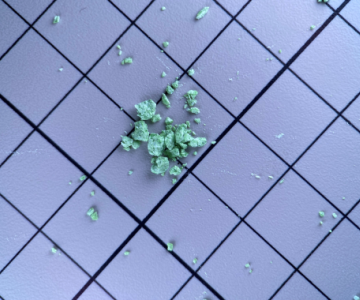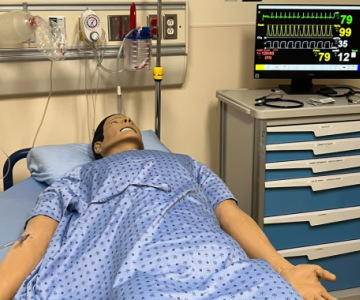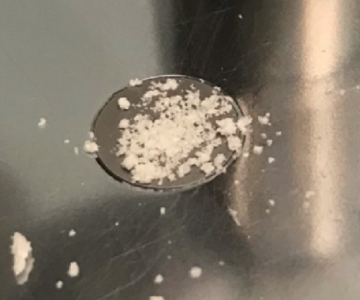Breadcrumb
- Home
- media
Explore Media
Toxic Drug Alert
Please see the attached document to learn more about the look, contamination, and risk associated with the current drug alert.
Toxic Drug Alert
Please see the attached document to learn more about the look, contamination, and risk associated with the current drug alert.
News Release
A fourth medical simulation centre has opened in Interior Health (IH) at Penticton Regional Hospital (PRH) in partnership with the University of British Columbia Southern Medical Program.
“It’s welcome news this fourth simulation centre will enhance patient care across the Interior region by providing health-care professionals and students with the opportunity to learn from realistic, safe medical scenarios,” said Adrian Dix, Minister of Health.
Simulation programs are designed to create medical scenarios providing health-care professionals and students with the most realistic experience for learning and refining procedures, patient care and team dynamics while in a safe environment. Simulation centres allow inter-professional teams to work together to practice, ideally in a similar environment with their own equipment, while also utilizing manikins, actors and more to help re-create major incidents.
“Simulation exercises create an environment for research to enhance the quality of our patient care and safety. Through simulation, we want to promote collaboration and learning so that participants are truly achieving excellence in health-care delivery,” said Dr. Jared Baylis, medical director for the Interior Health simulation program and medical education simulation lead for the Southern Medical Program. “Exercises can help strengthen skills and team communication, prompt reviews of specific protocols and may encourage teams to make changes to optimize workflow, space design and much more.”
In October 2022, the IH/UBC Simulation Program became the only program in B.C. to be accredited by the Royal College of Physicians and Surgeons of Canada. The program also offers many sessions accredited by the UBC Continuous Professional Development program, earning Continuous Medical Education credits for practising physicians and medical staff.
The simulation program started in 2009 in the Kootenays with rural physician Dr. Jeff Plant and clinical nurse educator Eve Burkart to support their rural colleagues in providing best-practice quality care to patients experiencing high-risk, low-frequency events such as cardiac arrest or trauma. Although an emerging educational tool at the time, the program quickly gained traction and was mobilized to support rural emergency departments throughout the IH network.
“It’s been fantastic to see this program grow from its beginnings in the Kootenay region to where we are now,” said Eve Burkart, clinical practice nurse educator with Interior Health. “Simulation greatly benefits the medical staff, students and the teams they work with as they gain exposure to a range of patient events that they might not see regularly during residencies and rotations. This team focus was, and continues to be, particularly important in rural areas. Simulation provides specific experiences and training to strengthen the provision of evidence-based care without any risk to a patient.”
In addition to the new Penticton centre, Interior Health has the Pritchard Simulation Centre in Kelowna, the Rae Fawcett Simulation Centre in Kamloops, the Kootenay Boundary Simulation Program in Trail, and the IH Rural Mobile Simulation Program that travels to 29 rural and regional sites.
“Simulation provides essential training that can really improve patient quality and safety. It's highly beneficial to learn and practice with real-life scenarios that includes all team members,” said Dr. Devin Harris, executive medical director, quality and patient safety, Interior Health. “Clinicians can learn and gain confidence and expertise in a supportive environment. This preparation will pay dividends for when an event does occur and will lead to healthier communities in the Interior.”
Interior Health, UBC Faculty of Medicine, and UBC Okanagan School of Nursing have embarked on this partnership to implement, operationalize and provide simulation education throughout the Interior Health region. The joint collaborative nature of the program allows the development of comprehensive patient curriculum for the benefit of staff, students and clinical practitioners who are located and practice within the geographic boundaries of Interior Health.
Toxic Drug Alert
Please see the attached document to learn more about the look, contamination, and risk associated with the current drug alert.
News Release
Interior Health and Thompson Region Division of Family Practice are pleased to announce that the Thompson Region Family Obstetrics (TRFO) clinic will begin accepting new referrals for expectant parents starting next week.
“This clinic is a vital resource for new and expecting families in Kamloops and surrounding communities who require access to local maternity care,” said Minister of Health Adrian Dix. “I want to applaud all the efforts that allowed these services to resume.”
Collaborative efforts between the Ministry of Health, Thompson Region Division of Family Practice, local maternity care providers, and Interior Health have addressed concerns related to the stability of the clinic, which resulted in a temporary interruption to referrals for new expectant parents.
The TRFO clinic provides care for parents and families in Kamloops and surrounding communities, like Merritt, Barriere, Ashcroft, Lillooet, Lytton, and Clearwater starting from early pregnancy up to six weeks following the birth of their babies. The clinic supports on average about 600 to 700 deliveries per year.
“Interior Health knows how important access to stable, quality care is for expectant parents and families,” said Susan Brown, Interior Health President and CEO. “We are committed to working with all partners to ensure this clinic is successful moving forward and to keeping patients at the heart of all these discussions.”
The TRFO clinic will start accepting new referrals next week, and work collaboratively with the newly opened antenatal care clinic to ensure timely access to care for expectant parents.
“TRFO physicians believe that the support provided by IH and the Ministry of Health for the clinic will help to ensure its ongoing sustainability,” said Dr. Shaun Davis, co-lead of the TRFO physician group. “We are optimistic that the supports put in place will allow for the permanent recruitment of family doctors who work in obstetrical care. The collaboration with the antenatal care clinic will ensure timely access to all maternity services in Kamloops.”
The Thompson Region Family Obstetrics clinic is located on the first floor of the Clinical Services Building at Royal Inland Hospital. It is open from 9 a.m. to 5 p.m. and offers 24-hour call shifts.
Community Update
Dear Community Leaders,
As we look towards summer 2023 with the potential of extreme heat and wildfires, Interior Health (IH) would like to share information and resources that can help protect residents in our region. We know that extreme heat and wildfire smoke can be serious health hazards. While weather events are outside our control, we can work together to prepare and apply what we have learned in recent years.
Heat and health
Heat events are projected to become hotter, more frequent and longer as the B.C. climate changes. Prolonged periods of extreme heat can lead to severe illness and death, and heat is the leading weather-related cause of death in Canada. People can be impacted differently and some are more at risk than others. Seniors, people with mental health conditions and children are most vulnerable to being harmed by extreme heat.
Indoors vs. outdoors
During the 2021 heat dome, the majority of deaths across B.C. occurred indoors in private residences. Inside our homes, temperatures continue to rise after the sun goes down and the evening is when indoor temperatures are the highest. This can be especially dangerous when there are consecutive hot days.
Being prepared can save lives during extreme heat. We encourage local governments to make plans and identify cooler spaces in the community, both inside and outside, and to help people who may need assistance to set up or move to cooler places during a heat event.
Preparing for extreme heat
BC Provincial Heat Alert and Response System (BC HARS): 2023 lays out criteria that Environment and Climate Change Canada (ECCC) will use to issue a Heat Warning or an Extreme Heat Emergency. Additionally, many municipalities are developing their own heat response plans. Preparing for extreme heat by developing systems and plans can save lives.
Actions community leaders can take:
Develop a community preparedness and response plan for extreme heat - here is an example from the Village of Ashcroft
Prepare community heat messages using trusted information from the British Columbia Centre for Disease Control (BCCDC) and/or Interior Health, and amplify heat warnings as appropriate
Promote and encourage neighbourhood check-ins during heat events, especially for the elderly and those more socially isolated
Extend the operating hours of cooled spaces (e.g., libraries, community centres) and publicize their locations/hours through all feasible media sources
Provide extended public access to amenities like drinking water, spray parks, swimming pools and shaded/covered areas
For rural communities, consider using a local school, meeting hall or other gathering place (including shaded outdoor areas) as a temporary cooling space
Consider establishing overnight cooling centres to support populations susceptible to heat
Actions Interior Health will take:
Support the development of community heat preparedness and response plans
Participate in regional briefing calls with local governments and First Nations to provide public health advice
Share heat warnings and broadcast public health messages about the prevention of heat-related illness
Provide public health messages that can be shared through community heat response communications
Develop and implement Interior Health organizational heat response plans
Monitor clients and patients who are vulnerable to heat-related illness
Provide public health surveillance data from previous heat events to inform decision-making
Smoke and air quality
As summers get hotter, wildfire activity due to climate change is predicted to increase. While heat is often more localized, wildfire smoke can blow in from other provinces and other countries; poor air quality can persist for days and be unpredictable.
People exposed to wildfire smoke may experience health impacts such as irritation of the nose and throat, cough and shortness of breath. People with chronic lung or heart conditions, infants, children and pregnant people, are at higher risk of complications.
Steps local governments can take to protect community members from the health impacts of wildfire smoke are:
Pay regular attention to local air quality advisories and publically share smoky skies bulletins; notice the levels of fine particulate matter (PM2.5)
Create or locate clean air shelters, or cleaner air spaces available to the public (libraries, shopping malls, community centres, etc.)
Educate residents about hazards and provide a plan to follow in case of a wildfire and/or smoke
Consider re-scheduling outdoor public events to reduce time spent outside in smoky conditions
Of special note
If there is extreme heat during an air quality advisory, people should prioritize cooling down. Heat is typically more dangerous than short-term exposure to poor air quality
While fans can help you feel more comfortable, they do not lower body temperature when outdoor and/or indoor temperatures are over 35C. At that point, fans simply blow hot air over the skin and can cause increased body temperature. When outdoor air temperatures are cooler than indoor air temperatures, use fans in windows to blow cooler air from outside into a room
Preparing for heat, and managing the health risks of extreme heat, must centre on those who are socially isolated and living with lower socio-economic status
Interior Health is committed to working with community partners in all sectors to protect the health of the population. The IH Healthy Communities Program and Office of the Medical Health Officers are available to support community planning related to heat and wildfires. You can find your assigned Healthy Communities team member here. Please contact us at healthycommunities@interiorhealth.ca
Sincerely,
(Signed)
Dr. Martin Lavoie
Interim Chief Medical Health Officer
Dr. Silvina Mema
Deputy Chief Medical Health Officer
Dr. Carol Fenton
Medical Health Officer
Dr. Jonathan Malo
Medical Health Officer
Dr. Sue Pollack
Medical Health Officer
Dr. Fatemeh Sabet
Medical Health Officer
Public Service Announcement
Unattached pregnant patients in the Kamloops area can now access the Midwifery Antenatal Care Clinic in Royal Inland Hospital to receive ongoing care before birth.
The clinic receives referrals from family doctors, nurse practitioners, midwives and the Kamloops Urgent Primary Care and Learning Centre (UPCLC). Patients who have had their initial appointments at the Kamloops UPCLC are automatically added to the referral list.
Patients who have not had a confirmed pregnancy with a dating ultrasound should book an initial appointment with a family doctor, nurse practitioner, midwife or the Kamloops UPCLC (250-314-2256) to be added to the referral list.
A member of the care team will reach out to all patients on the referral list via phone by June 19 to book appointments based on their due dates and other specific needs. Instructions will be given directly to patients in these calls.
To contact the Midwifery Antenatal Care Clinic, please dial 250-314-2782 and select 1 to leave a message. Staff check messages frequently and will respond in a timely manner.
We encourage patients to also connect with Healthy from the Start (855-868-7710) for additional support and information. This is a toll-free, confidential phone line that connects patients with a public health nurse, who will share information, answer questions and help you get connected to resources in the community.
Public Service Announcement
Salmon Arm and area residents are advised lab services at the Shuswap Outpatient Collection Lab at #2 - 2770 10 Ave NE, Salmon Arm will be unavailable from June 5-9, 2023 to allow for a safe and smooth transition into a new space.
During this week, patients requiring urgent bloodwork only can present at Shuswap Lake General Hospital between 7:30 a.m. – 3:30 p.m. Patients with routine bloodwork are asked to kindly wait until the new space opens on June 12. Additional staff will be available upon reopening to help attend to those who had to wait for their routine blood work.
The upgraded Outpatient Collection Lab is being relocated to vacant space within the existing building. Community residents will experience a more modern environment with improved accessibility and efficiency of services.
Toxic Drug Alert
Please see the attached document to learn more about the look, contamination, and risk associated with the current drug alert.
-
Load More
Showing 531 of 1083





